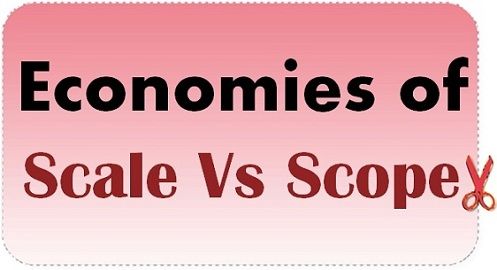 Economies of Scale and Economies of scope are two important strategies used by most of the organizations to gain cost effectiveness. The economies of scale, represents the savings in cost of production by increasing the scale of production or the size of the plant.
Economies of Scale and Economies of scope are two important strategies used by most of the organizations to gain cost effectiveness. The economies of scale, represents the savings in cost of production by increasing the scale of production or the size of the plant.
On the other hand, economies of scope refer to the benefits obtained due to producing multiple products using the same operations efficiently. Economies of scope, is nothing but the savings in cost received by producing two or more distinct goods, when the cost of production so, relatively less than producing it separately.
People get confused between these two techniques easily as they both results in a proportionate saving in cost of production. But, there is a difference between economies of scale and economies of scope, which has been discussed in this article in detail. Have a look.
Content: Economies of Scale Vs Economies of Scope
Comparison Chart
| Basis for Comparison | Economies of Scale | Economies of Scope |
|---|---|---|
| Meaning | Economies of scale refers to savings in the cost due to increase in output produced. | Economies of scope means savings in cost due to the production of two or more distinct products, using same operations. |
| Reduction in | The average cost of producing one product. | The average cost of producing multiple products. |
| Cost advantage | Due to volume | Due to variety |
| Strategy | Old | Relatively New |
| Involves | Product standardization | Product diversification |
| Use of | Large amount of resources | Common resources |
Definition of Economies of Scale
By the term economies of scale, we mean the increase in the efficiency of production due to the increase in size, output or activity level. Economies of scale occur due to the indirect relationship between the quantity produced and the per unit cost of production. This is because the fixed cost remains same irrespective of the level of production employed by the organisation.
Therefore, with the rise in the scale of operation, the fixed cost is distributed evenly over the quantity produced. So with every additional unit produced, the average cost of production tends to decline. Along with that, variable cost per unit also decreases, due to operational efficiency and synergy. In this way, the enterprise gains cost effectiveness. There can be internal and external economies of scale.
Definition of Economies of Scope
Economies of Scope refers to the reduction in the average cost per unit, by increasing the variety of products produced. In this technique, the total cost of producing two products (related or unrelated) is less than the cost of producing each item individually.
Economies of Scope focuses on better utilisation of the firm’s resources and common assets. In this way, the utilisation of assets is spread over two or more products, i.e. shared by multiple products to decrease the overall cost of production. As the costs are spread over several products which lead to the decrease in the average cost per unit of each product.
Key Differences Between Economies of Scale and Economies of Scope
The major points of difference between economies of scale and economies of scope are explained below:
- A strategy used for cutting costs by increasing the volume of units produced is known as Economies of Scale. Economies of Scope implies a technique to lower down the cost by producing multiple products with the same operations or inputs.
- In economies of scale is implemented, the average cost of producing a product is reduced. On the other hand, economies of scope imply proportionate savings in the cost of producing multiple products.
- In economies of scale, the firm gains cost effectiveness due to volume, whereas cost effectiveness in economies of scope is due to the varieties offered.
- Economies of scale strategy are used by organisations since a long time. Conversely, Economies of Scope is a relatively new strategy.
- Economies of scale involve product standardisation while economies of scope involve product diversification, using the same scale of the plant.
- In economies of scale, a bigger plant is used to produce the large volume of output. As opposed to economies of scope, in which the same plant is used to manufacture distinct products.
Conclusion
In this era of competition, it is very important for the firms to cut down their excess costs, to offer their products at low prices and expand their share in the market. Both economies of scale and economies of scope result in the savings in cost, but their concept is different, whereby one lowers the cost by increasing the volume of output and the other by increasing the number of products it offers.






JAMES CATER says
it’s a relevant information, thank you
Pushpender Sharma says
Quantity demanded for tea has increased from 300 to 450 units with an increase in the
price of the coffee powder from Rs 25 to Rs 30. Calculate the cross elasticity of demand
between tea and coffee and explain the relationship between the goods.